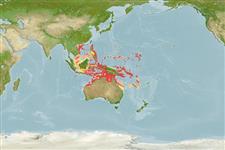>
Ovalentaria/misc (Various families in series Ovalentaria) >
Pomacentridae (Damselfishes) > Pomacentrinae
Etymology: Pomacentrus: Greek, poma, -atos = cover, operculum + Greek, kentron = sting (Ref. 45335).
More on authors: Fowler & Bean.
Environment: milieu / climate zone / depth range / distribution range
Écologie
marin récifal; non migrateur; profondeur 3 - 70 m (Ref. 9710). Tropical; 21°N - 25°S, 104°E - 171°E
Indo-Pacific: Philippines and Celebes to the Solomon Islands and Vanuatu, and the Great Barrier Reef; Palau in Micronesia (Ref. 7247). Reported from the Mentawai Islands, Indonesia.
Taille / Poids / Âge
Maturity: Lm ? range ? - ? cm
Max length : 9.0 cm TL mâle / non sexé; (Ref. 7247)
Description synthétique
Clés d'identification | Morphologie | Morphométrie
Épines dorsales (Total) : 13; Rayons mous dorsaux (Total) : 13 - 15; Épines anales: 2; Rayons mous anaux: 15 - 16.
Adults occur in steep outer reef slopes and deep lagoons to moderate depths. Generally solitary among large rubble pieces or the bases of large corals (Ref. 48636). Oviparous, distinct pairing during breeding (Ref. 205). Eggs are demersal and adhere to the substrate (Ref. 205). Males guard and aerate the eggs (Ref. 205). Diurnal species (Ref. 52881).
Life cycle and mating behavior
Maturities | Reproduction | Spawnings | Egg(s) | Fecundities | Larves
Oviparous, distinct pairing during breeding (Ref. 205). Eggs are demersal and adhere to the substrate (Ref. 205). Males guard and aerate the eggs (Ref. 205).
Allen, G.R., 1991. Damselfishes of the world. Mergus Publishers, Melle, Germany. 271 p. (Ref. 7247)
Statut dans la liste rouge de l'IUCN (Ref. 130435)
Menace pour l'homme
Harmless
Utilisations par l'homme
Outils
Articles particuliers
Télécharger en XML
Sources Internet
Estimates based on models
Preferred temperature (Ref.
123201): 26.2 - 28.9, mean 27.8 °C (based on 346 cells).
Phylogenetic diversity index (Ref.
82804): PD
50 = 0.5000 [Uniqueness, from 0.5 = low to 2.0 = high].
Bayesian length-weight: a=0.02399 (0.01139 - 0.05051), b=2.98 (2.81 - 3.15), in cm total length, based on LWR estimates for this Genus-body shape (Ref.
93245).
Niveau trophique (Ref.
69278): 2.6 ±0.28 se; based on food items.
Résilience (Ref.
120179): Haut, temps minimum de doublement de population inférieur à 15 mois (Preliminary K or Fecundity.).
Fishing Vulnerability (Ref.
59153): Low vulnerability (10 of 100).
Nutrients (Ref.
124155): Calcium = 125 [60, 190] mg/100g; Iron = 0.819 [0.497, 1.370] mg/100g; Protein = 18.1 [16.9, 19.2] %; Omega3 = 0.128 [0.075, 0.208] g/100g; Selenium = 29.5 [15.7, 55.2] μg/100g; VitaminA = 87.4 [22.8, 309.1] μg/100g; Zinc = 1.9 [1.3, 2.7] mg/100g (wet weight);
